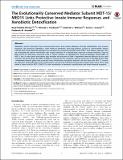| dc.contributor.author | Pukkila-Worley, Read | en_US |
| dc.contributor.author | Feinbaum, Rhonda L. | en_US |
| dc.contributor.author | McEwan, Deborah L. | en_US |
| dc.contributor.author | Conery, Annie L. | en_US |
| dc.contributor.author | Ausubel, Frederick M. | en_US |
| dc.date.accessioned | 2014-07-07T17:01:27Z | |
| dc.date.issued | 2014 | en_US |
| dc.identifier.citation | Pukkila-Worley, Read, Rhonda L. Feinbaum, Deborah L. McEwan, Annie L. Conery, and Frederick M. Ausubel. 2014. “The Evolutionarily Conserved Mediator Subunit MDT-15/MED15 Links Protective Innate Immune Responses and Xenobiotic Detoxification.” PLoS Pathogens 10 (5): e1004143. doi:10.1371/journal.ppat.1004143. http://dx.doi.org/10.1371/journal.ppat.1004143. | en |
| dc.identifier.issn | 1553-7366 | en |
| dc.identifier.uri | http://nrs.harvard.edu/urn-3:HUL.InstRepos:12406540 | |
| dc.description.abstract | Metazoans protect themselves from environmental toxins and virulent pathogens through detoxification and immune responses. We previously identified a small molecule xenobiotic toxin that extends survival of Caenorhabditis elegans infected with human bacterial pathogens by activating the conserved p38 MAP kinase PMK-1 host defense pathway. Here we investigate the cellular mechanisms that couple activation of a detoxification response to innate immunity. From an RNAi screen of 1,420 genes expressed in the C. elegans intestine, we identified the conserved Mediator subunit MDT-15/MED15 and 28 other gene inactivations that abrogate the induction of PMK-1-dependent immune effectors by this small molecule. We demonstrate that MDT-15/MED15 is required for the xenobiotic-induced expression of p38 MAP kinase PMK-1-dependent immune genes and protection from Pseudomonas aeruginosa infection. We also show that MDT-15 controls the induction of detoxification genes and functions to protect the host from bacteria-derived phenazine toxins. These data define a central role for MDT-15/MED15 in the coordination of xenobiotic detoxification and innate immune responses. | en |
| dc.language.iso | en_US | en |
| dc.publisher | Public Library of Science | en |
| dc.relation.isversionof | doi:10.1371/journal.ppat.1004143 | en |
| dc.relation.hasversion | http://www.ncbi.nlm.nih.gov/pmc/articles/PMC4038581/pdf/ | en |
| dash.license | LAA | en_US |
| dc.subject | Biology and Life Sciences | en |
| dc.subject | Immunology | en |
| dc.subject | Immune System | en |
| dc.subject | Innate Immune System | en |
| dc.subject | Immunity | en |
| dc.subject | Microbiology | en |
| dc.subject | Organisms | en |
| dc.subject | Animals | en |
| dc.subject | Invertebrates | en |
| dc.subject | Nematoda | en |
| dc.subject | Caenorhabditis | en |
| dc.subject | Caenorhabditis Elegans | en |
| dc.subject | Medicine and Health Sciences | en |
| dc.subject | Infectious Diseases | en |
| dc.subject | Bacterial Diseases | en |
| dc.subject | Pseudomonas Infections | en |
| dc.subject | Pathology and Laboratory Medicine | en |
| dc.subject | Pathogenesis | en |
| dc.subject | Host-Pathogen Interactions | en |
| dc.subject | Model Organisms | en |
| dc.subject | Animal Models | en |
| dc.title | The Evolutionarily Conserved Mediator Subunit MDT-15/MED15 Links Protective Innate Immune Responses and Xenobiotic Detoxification | en |
| dc.type | Journal Article | en_US |
| dc.description.version | Version of Record | en |
| dc.relation.journal | PLoS Pathogens | en |
| dash.depositing.author | Pukkila-Worley, Read | en_US |
| dc.date.available | 2014-07-07T17:01:27Z | |
| dc.identifier.doi | 10.1371/journal.ppat.1004143 | * |
| dash.contributor.affiliated | Conery, Annie | |
| dash.contributor.affiliated | Pukkila-Worley, Read | |
| dash.contributor.affiliated | Feinbaum, Rhonda | |
| dash.contributor.affiliated | Ausubel, Frederick | |


